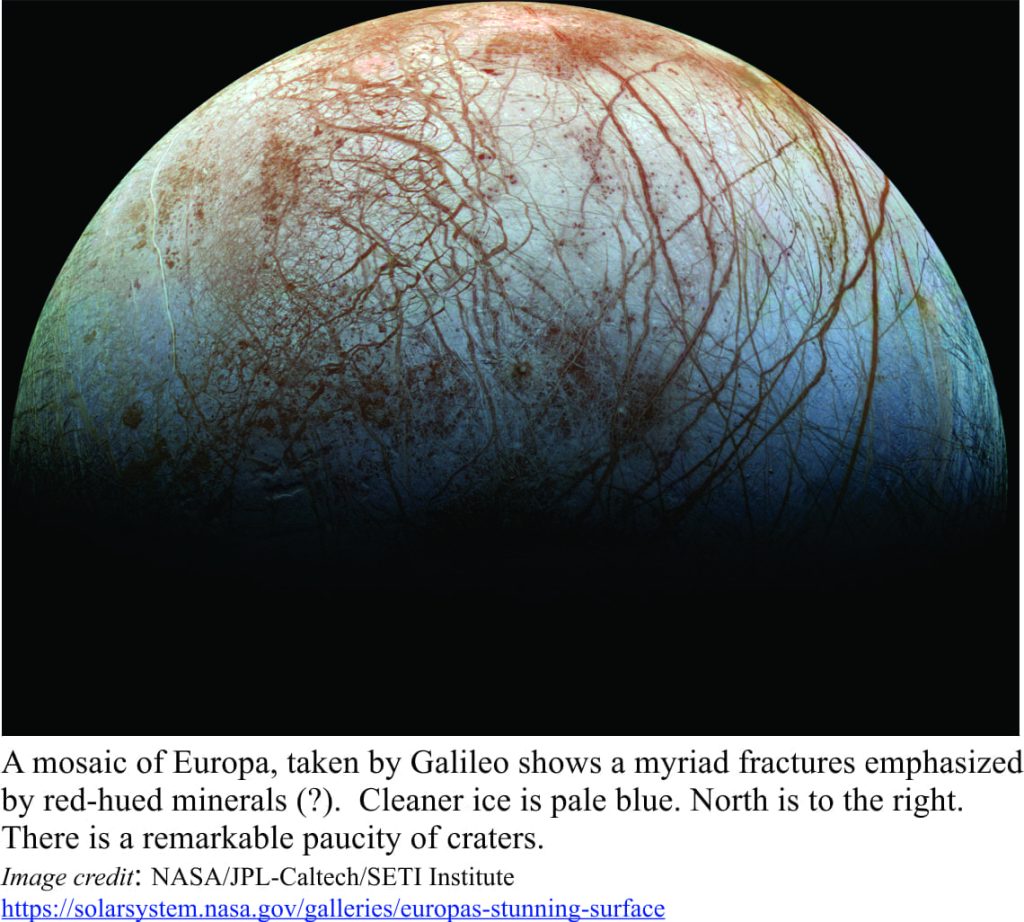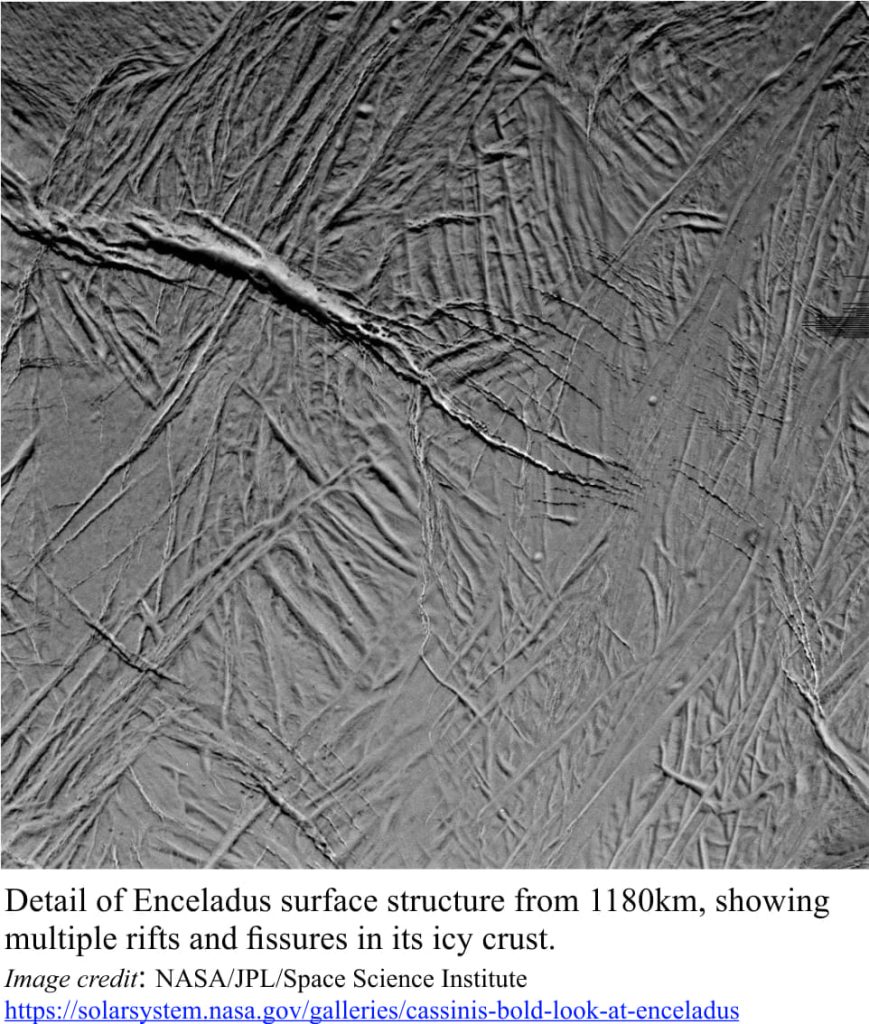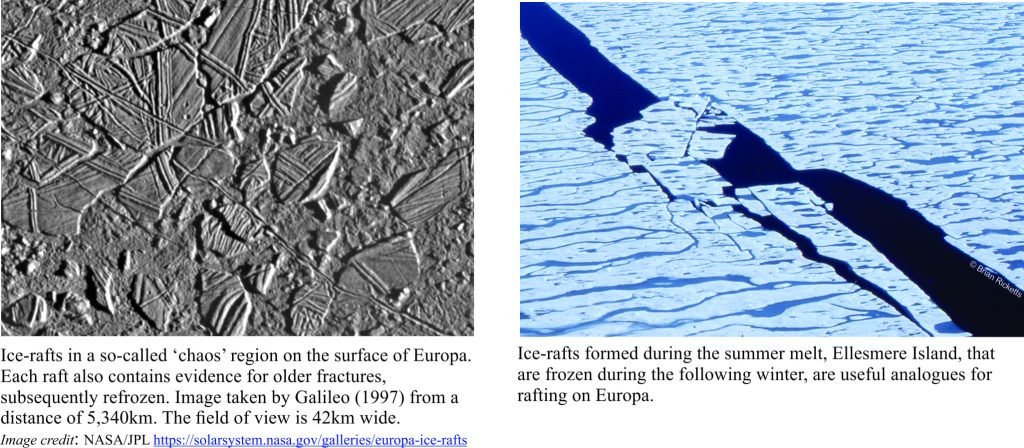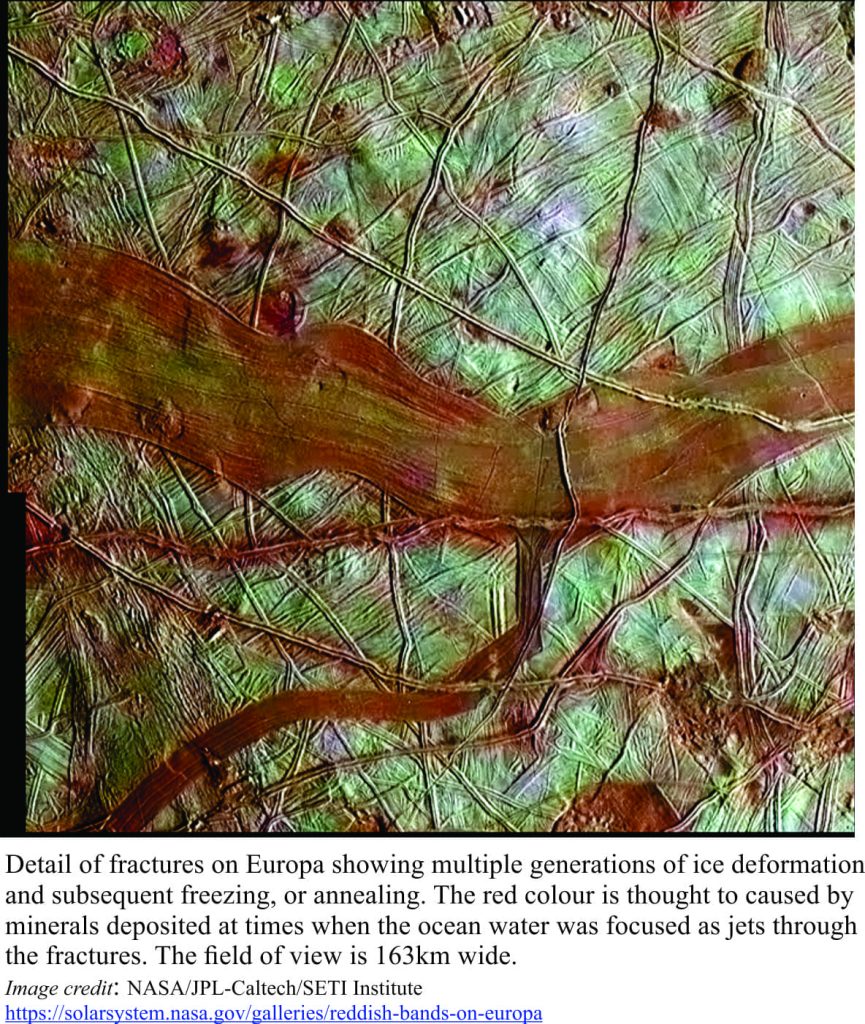Our blue Earth, rising above the lunar horizon, is an abiding image of our watery state that must evoke an emotional response in any sensible person. Cloud-swirled, Van Gogh-like. Such a blue – there’s nothing like it, at least in our own solar system. A visitor to Mars three billion years ago might have also seen a red planet daubed blue, but all those expanses of water have since vanished, replaced by seas of sand.
Earth’s oceans are unique in our corner of the universe. Except for a thin carapace of ice at the poles, they are in a liquid state, and are in direct contact with the atmosphere to the extent that feed-back processes control weather patterns and climates. Sufficient gravitational pull plus the damping effect of our atmosphere, prevents H2O from being stripped from our planet by solar radiation (again, unlike Mars). Our oceans exist because of this finely tuned balancing act.
The discovery in 2005 of liquid water on other planetary bodies in the Solar System, was a momentous event. Spacecraft Cassini provided the data during its flyby of Enceladus, a diminutive moon of Saturn (radius is only 252km). Cassini discovered water vapour in geysers, or plumes jetting from Enceladus’ surface. In 2013, Hubble added to the excitement when it imaged what many astronomers interpreted as a vapour plume erupting from Europa, one of Jupiter’s icy moons.
Hubble’s analysis indicated both hydrogen and oxygen in the vapour, most likely as water. Logic, and our knowledge of physical processes dictate that the water vapour in both cases is likely derived from liquid water. But unlike Earth’s ruffled oceans, the water on Enceladus and Europa lies beneath icy crusts; the oceans on these moons are subcutaneous.
Discovery of the plumes confirmed previous (scientific) suspicions that Enceladus possessed a liquid ocean. Two additional lines of evidence include: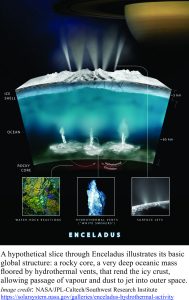
- Its orbit around Saturn is perturbed by a wobble that can only be explained by a liquid interior, and
- A density of 1.61 grams per cubic centimeter (g/cc) is significantly greater than the average density of the gas giant Saturn (about 0.69 g/cc); for comparison, water has a density of 1 g/cc, and Earth averages 5.51 g/cc. Enceladus’ density is reasonably explained by a global model that pictures a rocky core, a liquid interior, and an icy crust.
Enceladus is one of the brightest objects in the Solar System, its smooth surface reflecting almost 100% of sunlight; the corresponding surface temperature is a cool -201oC. There are craters in various states of preservation, but large tracts have no craters at all, suggesting that the icy surface has been renewed from time to time. Large fractures, particularly in the south pole region have been nicknamed ‘tiger stripes’; these fissures are the locus of vapour jets and sprays. Material from the jets is incorporated into Saturn’s E-ring (Enceladus orbits Saturn within the E-ring).
Following the discovery, Cassini was reprogrammed to do several flybys, including five trips through the plumes. On-board analysis (using a mass spectrometer) shows the vapour consists mostly of water, with minor carbon dioxide. Trace compounds that have also caused some excitement include ammonia (NH3), Hydrogen (H2) and several organic molecules including benzene species (6 carbon atoms joined in a hexagon).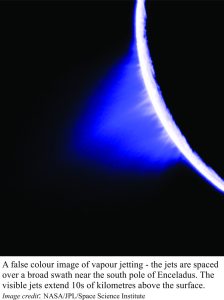 Ice particles in the plume also contain sodium – it appears the subcutaneous ocean is salty. Nano-scale particles of silica (a few billionths of a metre) have also been discovered which helps to confirm the rock core, but also suggests that temperatures deep in the ocean could be as high as 90oC. Temperatures this high would promote chemical reactions between the ocean water and the rocky core.
Ice particles in the plume also contain sodium – it appears the subcutaneous ocean is salty. Nano-scale particles of silica (a few billionths of a metre) have also been discovered which helps to confirm the rock core, but also suggests that temperatures deep in the ocean could be as high as 90oC. Temperatures this high would promote chemical reactions between the ocean water and the rocky core.
The data, exciting as it is, presents something of a conundrum; significant heat is required to maintain a liquid ocean (i.e. to prevent it from freezing solid), particularly if toasty warm hydrothermal activity is also present. Current thinking invokes tidal friction as a source of heat. Enceladus’ orbit is slightly elliptical, such that the moon develops a slight bulge when it is closest to Saturn (it is pulled out of shape), but returns to an almost spherical form when farthest away. The process is analogous to our own moon’s gravitational effect that produces ocean tides. Recent modelling suggests that most of this heat is generated in the core and transferred to the liquid ocean.
Not to be outdone, Jupiter’s moon Europa (image at top of page), a bit smaller than our own lunar orb, has an icy surface riven by fractures and ice rafts, but very few craters, all indicating a tectonically active, geologically young crust. In fact, some regions appear quite broken and jumbled, and are referred to as chaos regions that may have formed by collapse of the crust. Ice rafts here bear an uncanny resemblance to rafted Arctic ice.
Like Enceladus, Europa too may have a subcutaneous liquid ocean. The primary evidence in this case is derived from measurements of Jupiter’s magnetic field (by spacecraft Galileo). The magnetic field generated by Jupiter is disturbed by Europa, in a way that is best explained by the moon containing a deep, salty, liquid ocean. The latest Hubble images of erupting plumes are helping to consolidate this hypothesis. Like Enceladus, it is probably heat, generated by tidal friction, that prevents the liquid mass from freezing.
Imaging of Europa’s surface by Galileo during one of its close encounters (about 22,000 km), shows an array of broken and fractured segments of ice; in the close-up image, fracture widths range from about a kilometre or less, to more than 50km. The detail illustrates a remarkable degree of ice fracturing and annealing over many generations. Red hues are thought to be mineral deposits which, if confirmed, would provide further evidence of a rocky core, and chemical interactions between the core and liquid ocean.
I never tire of seeing the new imagery and data that the various space probes and telescopes produce. Every week seems to herald some new discovery. Cassini, of course, has done its bit for science. Next in line is Europa. Europa Clipper, a tall-ship name given to a new-generation space probe, has become a NASA priority, planned for the 2020s. Clipper may also act as a pathfinder for a future robotic lander mission. In both missions, the possibility that Europa’s ocean might harbour life forms is never far from scientists’ planning (and perhaps dreaming). The onboard instruments will certainly be tasked with this in mind.
Meanwhile, there are years of Cassini and Galileo data still to be analysed. The science never stops.
